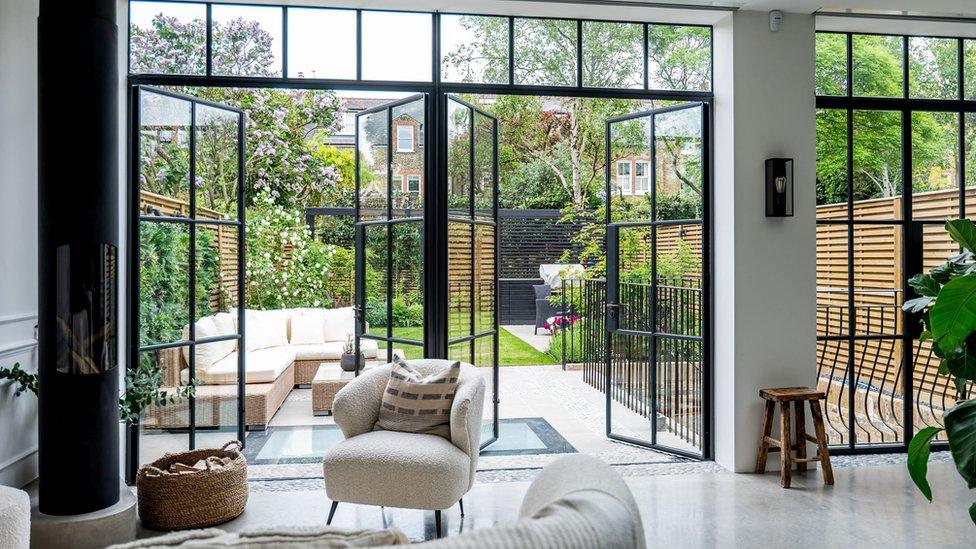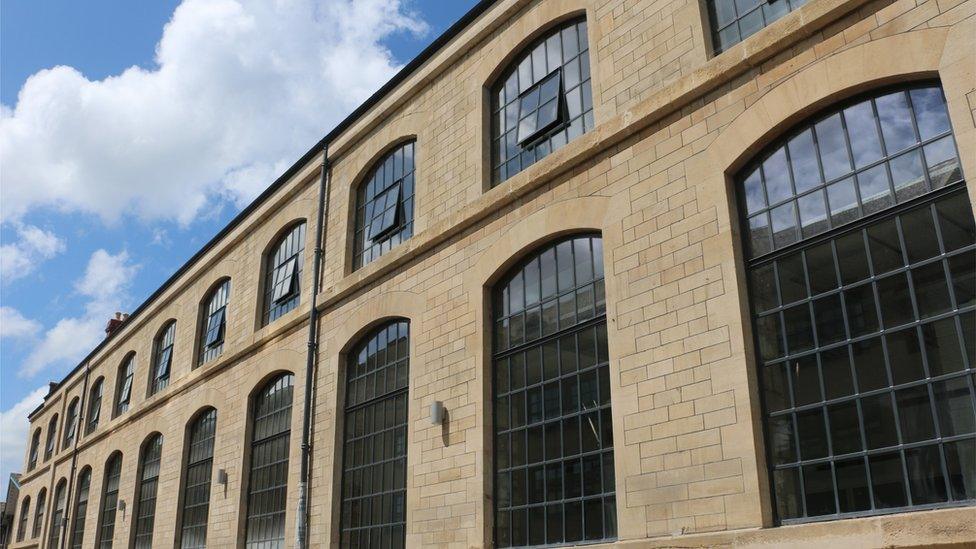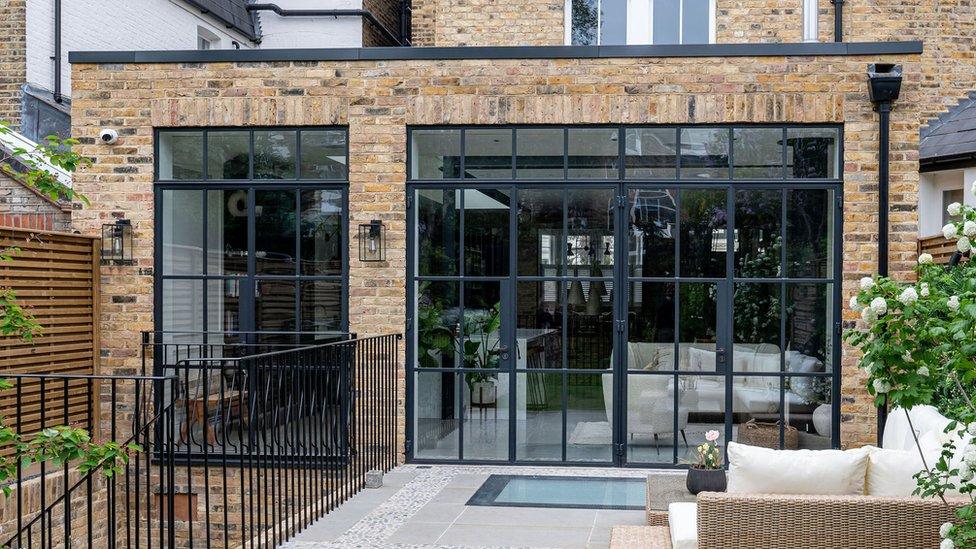The challenge of upgrading iconic steel windows
- Published

Critall windows have made big changes to their iconic frames
Every winter, architect Kevin Adams would perform his early morning ritual of devotion. Cloth in hand, he'd head to the stylish Crittall windows in the East London flat where he once lived - because these windows, though stylish, were also sopping wet.
"You'd know to expect it - you wipe it down, you open the window as soon as you can, you don't let it puddle or rot the sills," he says of the moisture that used to form on the single-glazing and thin steel frames of his windows when the weather was cold.
"I put up with it because I loved them. We do all kinds of things for love, don't we?"
Not everyone who has lived with vintage steel-framed windows feels so affectionate towards them, however.
Crittall Windows became synonymous both with modernism - and condensation, which can lead to serious problems such as mould, says Mr Adams, a teaching fellow at the Edinburgh College of Art.
While many consider such windows iconic and a key part of British architectural heritage, given today's high energy prices and rising awareness around the dangers of mould, efficient windows have become essential. Crittall, like all other companies in the glazing industry, has had to stay relevant to survive.

Critall have been making steel framed windows since the 1880s
The firm, now based in Witham, Essex, has been manufacturing steel-framed windows since the 1880s. The frames Crittall developed could be mass produced, then simply cut and welded to fit an array of standard window sizes, external.
The style was popular in both commercial and residential buildings during the 1920s and 1930s but also after World War Two, says Adams. "Perfect for a post-war economy that was mass building without much money and with a shortage of materials," he explains.
Factories and warehouses often benefitted from metal-framed windows - lightweight but strong steel meant the frames could be extra thin, allowing more room for glass, which let natural light flood through. Workers appreciated this - but so did the wealthy, who wanted light, airy homes.
A large, art deco country house built by Walter Crittall in the 1930s was listed for sale, external last year at £1.65m.
On the Crittall factory floor today, there is a machine that dates to the 1920s. It is still used occasionally for gently bending steel frame sections into curved pieces, says managing director Russell Ager: "It's an incredible piece of kit."
But the company has moved on in many other ways, he stresses, and nearby machines in the building are now state-of-the-art. "We've done so much work to improve the thermal performance of the products," adds Mr Ager.
Today you can get double and even triple-glazed Crittall windows. And crucially, the steel frames are now made with a thermal break, a glass fibre section of insulation within the frame that prevents heat escaping through its structure.
The lack of a thermal break is what made the older frames so prone to becoming cold when the weather outside was chilly. Cold glass and steel encourage moisture in the indoor air to condense.
The latest Crittall windows can achieve a U-value - a measure of their insulating performance - as low as 0.8, which is better than standard double-glazed windows.
They are heftier than the vintage versions but Crittall has retained the classic look of relatively skinny metal frames and rectangular or square panes of glass. TikTok and Instagram accounts focusing on home décor often feature windows such as this, though Crittall has many competitors now that make similar-looking products, admits Mr Ager.

Critall windows were popular in factories including the former site of crane maker Stothert & Pitt in Bath
According to Mr Adams, in the post-war era, there weren't many other firms operating in the same market as Crittall in the UK. But that has changed. Many companies, including KJM Group and Velfac offer aluminium alternatives. And there are other steel window makers out there, too, such as Fabco.
"Most consumers… buy our product because they love the look of it," says Mr Ager. Business, at the moment, is good.
During the early stage of the Covid-19 pandemic, Crittall's sales to residential customers seeking to improve their properties spiked by 30%. And while this was then followed by a decrease, currently the firm's orders in 2024 are up 20% on last year already, says Mr Ager.


Dated heritage installations reaching the end of their life present another opportunity. Crittall recently replaced 100-year-old windows that the firm had made for a building in Central London, external with new, energy efficient versions of the same products.
This kind of upgrade is not accessible to all, however, because of the relatively high cost of contemporary glazing, notes Claire Bennie, director of Municipal, a housing design and development consultancy.
"Every year we have a chat about it at our AGM and everyone is afraid of taking the plunge," she says, referring to residents' meetings at the block of 1930s flats in London where she lives. The old Crittall windows in the property give the building "elegance", says Ms Bennie but also makes them "freezing".
Her own flat's windows are not prone to condensation - but only because they are so draughty that they stay well-ventilated, she explains.
It will be increasingly difficult to justify the installation of new metal-framed windows in the future because of the embodied carbon in materials such as steel, says Ms Bennie. To reduce emissions and tackle climate change, sustainable timber building products ought to become more and more prominent, she argues.

Steel frames might become hard to justify in the future due to their high carbon footprint
Mr Ager says Crittall windows are made with 100% recycled steel and the company is working to make its products and operations as sustainable as possible.
Other challenges facing the company in the coming years, include the possibility that building regulations in England will change, so as to demand extremely energy efficient windows in new build properties. Stricter standards could mean a need to make the frames thicker still and even better insulated, says Mr Ager: "The frames would almost become unrecognisable. It would be a big issue for anybody that makes a metal frame."
Sustainability is paramount, stresses Ms Bennie, but she does say the ergonomic design of Crittall windows is hard to beat. The windows are often easy to open into a position where you can reach outside and clean them yourself, for instance. And the classic balcony doors made by the firm fold back neatly so as not to take up precious space outside.
"I wish modern window manufacturers would take a lesson from Crittall," she says, "In how to make windows liveable and a pleasure to use."